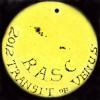Transit of Venus 2012: General Orientation by Roy Bishop
From the third planet, only Mercury and Venus can be seen silhouetted against the Sun. When an inferior conjunction takes place, the appreciable orbital inclinations of Mercury and Venus usually cause them to pass north or south of the solar disk and no transit occurs. Transits are uncommon for Mercury, rare for Venus. During the 20th century, there were 14 transits of Mercury, and 0 transits of Venus. Currently, transits of Venus occur in pairs, with 8.0 years separating the members of a pair, and the pairs separated alternately by 105.5 and 121.5 years, resulting in a 243.0-year period for the pattern.
Johannes Kepler, extraordinary astronomer and author of the Rudolphine Tables of planetary positions, predicted the Venus transit of 1631. Unfortunately, he died in 1630. Jeremiah Horrocks and his friend William Crabtree, in England, were the first to see a transit of Venus, on 1639 Dec. 4. Beginning with the transit pair in that century, years having Cytherean transits include: 1631/1639D, 1761/1769J, 1874/1882D, 2004/2012J, 2117/2125D, where “D” denotes a pair occurring in December, “J” in June. Kepler’s third law, later explained by Newton’s mechanics, links the relative sizes of the planetary orbits to their timed periods of revolution, but how can the absolute size of any one orbit be determined? The English astronomer Edmund Halley (1656–1742) emphasized that observations of a transit of Venus from locations widely separated in latitude could be used to determine the size of Earth’s orbit, and hence, via Kepler’s third law, the scale of the Solar System. Halley developed the technique mathematically, and outlined a practical way to carry out the enterprise. Just as he knew he would not live to see his predicted return of “his” comet, Halley again reached beyond his own mortality to urge astronomers to go to the ends of the Earth to observe the 18th-century Cytherean transits and thereby attain the first step in determining the scale of the Universe.
Difficulties with weather, with establishing accurate positions for observing sites, and the Seven Years War between England and France limited efforts to carry out Halley’s plan in 1761, but with the Treaty of Paris in 1763, an unprecedented effort was launched to observe the 1769 transit. It was the first worldwide, international venture in the name of science. The most famous of the expeditions was that sponsored by England’s Royal Society and led by Lieutenant James Cook (later Captain Cook) of the Royal Navy, who observed the transit from Tahiti. His ship on that legendary voyage was the bark Endeavour, after which NASA named one of its Space Shuttles. The British Admiralty chose Cook because of his reputation as an outstanding seaman, captain, hydrographer, and astronomical observer while on the east coast of present-day Canada during the years 1758-1767. During that period, Cook spent more time in Halifax, Nova Scotia, than in any other one location during his adult life.
The 1874/1882 transits were also widely observed, but by then advances in astronomical knowledge and technology had altered the best way to determine the scale of the Solar System. Observations of asteroids were providing results of higher accuracy. Yet the transit results were remarkably good. In 1890, Simon Newcomb, a native of Nova Scotia and Director of the Nautical Almanac Office of the U.S. Naval Observatory, re-examined the 1761 and 1769 transit observations. By using accurate longitudes for the observation sites, he arrived at a value for the astronomical unit that lies within 0.1% of today’s value. Occasionally, one reads a superficial reference to the 18th-century transit observations stating that these efforts were generally unsuccessful. Newcomb’s result indicates otherwise.
Today, precision timing of signals from interplanetary spacecraft and of radar reflections from Mercury, Venus, and Mars provide the best data, far surpassing those available from transit observations. Yet transits of Venus remain of great interest, because of their rarity and because of their place in the history of astronomy. The 2012 Jun. 5/6 transit is the first repetition of the second of a pair of June transits since James Cook and his astronomer Charles Green were on Tahiti, 243 years ago, and is the last transit of Venus that anyone now alive will ever experience.
This article first appeard in the Observer's Handbook 2012, p. 9. We thank Dr. Bishop and David M.F. Chapman for permission to reproduce it here.
| Attachment | Size |
|---|---|
| 1.6 MB |
- Log in to post comments





